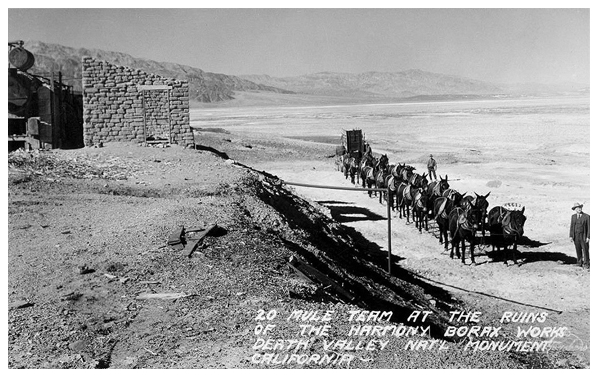Borax at Death Valley
1880's
Photo by Burton Frasher
A booming economy flourished as Borax was discovered in and around Death Valley and miners poured into this region hoping for the “mother lode”. Soon, mining related businesses, railroads, and workers began populating the Mojave Desert. New growth within this region developed as tents gave way to building, which grew into small towns. The nearby town of Newberry Springs was first choice for Santa Fe Railroad, when deciding to establish a major crossroads that would bring people and supplies to this region. But the towns people saw a chance to make a profit, raised the prices of property far too high and the Santa Fe Railroad moved over to the sleepy little town that now bears the middle name of William Barstow Strong, the 10th President of the Santa Fe Railroad Company.
Notes: Harmony Borax Works – Death Valley National Park
Located near Furnace Creek, the Harmony Borax Works played a key role in the early development of Death Valley’s mining history. Borax—also known as “white gold of the desert”—was discovered in 1881 in the clay flats near what was then called Greenland Ranch. This led to the formation of the Harmony operation by San Francisco businessman William Tell Coleman.
Processing began in 1883. Workers scraped borate-rich mud from the valley floor, then refined it in large vats using a boiling and settling method. The refined product—borax—was then hauled out of the valley on massive wagons pulled by Coleman’s famous 20-mule teams. These teams traveled over 160 miles of unforgiving desert to reach the railhead in Mojave. The route, the wagons, and the mule teams soon became icons of the American West.
Despite the ingenuity and determination behind the operation, Harmony Borax Works had a short life. The plant shut down in 1888 after only five years. Still, the site stands today as a physical reminder of Death Valley’s industrial roots—weathered wagons, adobe ruins, and interpretive signs share the story of enterprise and endurance in one of the harshest environments in North America.
Today, Harmony Borax Works is near the Furnace Creek area and remains one of the most visited historic sites in the park. It marks the beginning of large-scale borax production in the region and continues to capture the imagination of those who walk its dusty path.